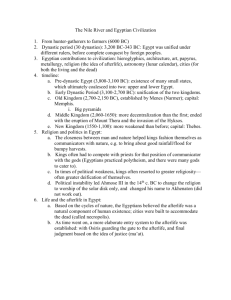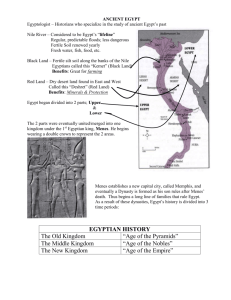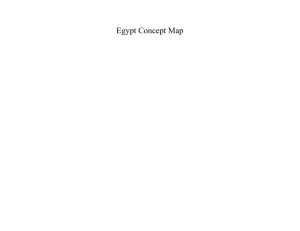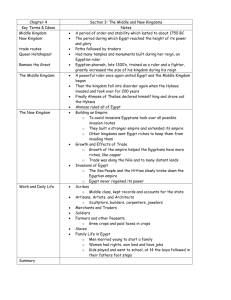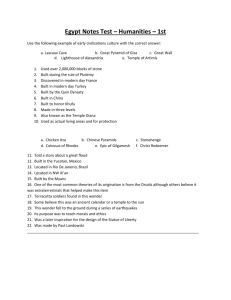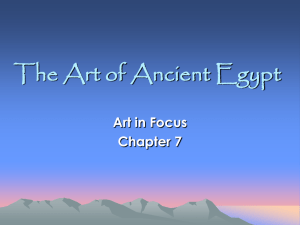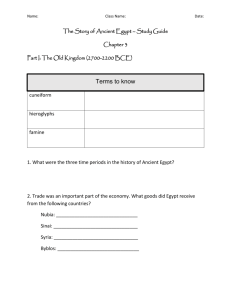Old Kingdom Egypt Lecture Notes
advertisement
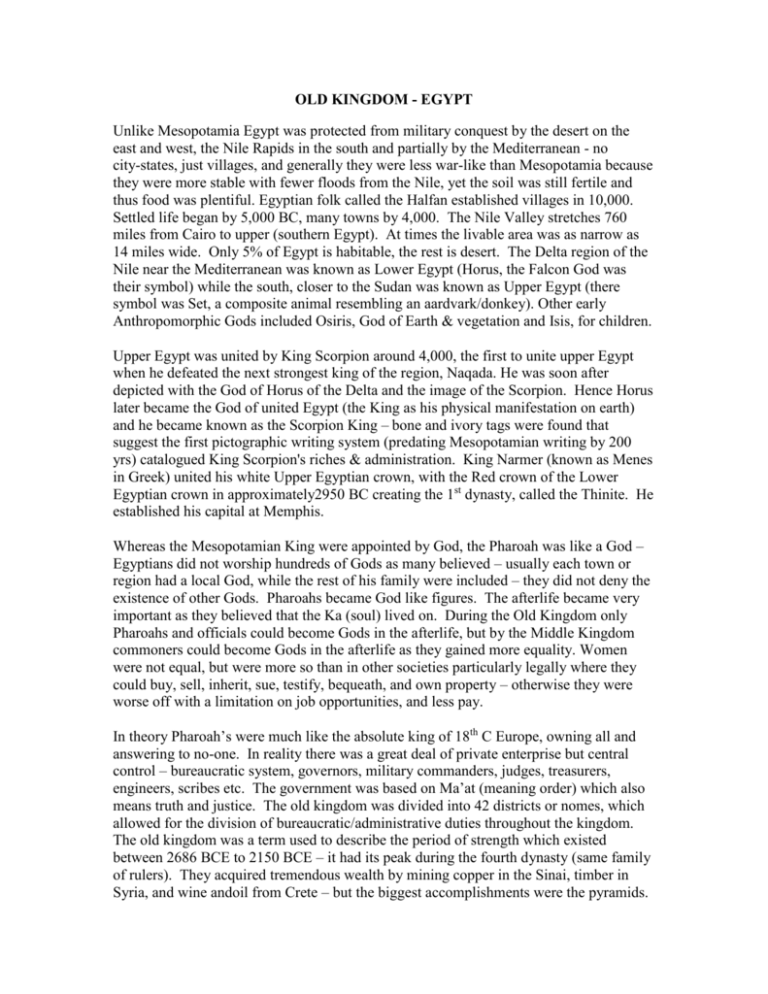
OLD KINGDOM - EGYPT Unlike Mesopotamia Egypt was protected from military conquest by the desert on the east and west, the Nile Rapids in the south and partially by the Mediterranean - no city-states, just villages, and generally they were less war-like than Mesopotamia because they were more stable with fewer floods from the Nile, yet the soil was still fertile and thus food was plentiful. Egyptian folk called the Halfan established villages in 10,000. Settled life began by 5,000 BC, many towns by 4,000. The Nile Valley stretches 760 miles from Cairo to upper (southern Egypt). At times the livable area was as narrow as 14 miles wide. Only 5% of Egypt is habitable, the rest is desert. The Delta region of the Nile near the Mediterranean was known as Lower Egypt (Horus, the Falcon God was their symbol) while the south, closer to the Sudan was known as Upper Egypt (there symbol was Set, a composite animal resembling an aardvark/donkey). Other early Anthropomorphic Gods included Osiris, God of Earth & vegetation and Isis, for children. Upper Egypt was united by King Scorpion around 4,000, the first to unite upper Egypt when he defeated the next strongest king of the region, Naqada. He was soon after depicted with the God of Horus of the Delta and the image of the Scorpion. Hence Horus later became the God of united Egypt (the King as his physical manifestation on earth) and he became known as the Scorpion King – bone and ivory tags were found that suggest the first pictographic writing system (predating Mesopotamian writing by 200 yrs) catalogued King Scorpion's riches & administration. King Narmer (known as Menes in Greek) united his white Upper Egyptian crown, with the Red crown of the Lower Egyptian crown in approximately2950 BC creating the 1st dynasty, called the Thinite. He established his capital at Memphis. Whereas the Mesopotamian King were appointed by God, the Pharoah was like a God – Egyptians did not worship hundreds of Gods as many believed – usually each town or region had a local God, while the rest of his family were included – they did not deny the existence of other Gods. Pharoahs became God like figures. The afterlife became very important as they believed that the Ka (soul) lived on. During the Old Kingdom only Pharoahs and officials could become Gods in the afterlife, but by the Middle Kingdom commoners could become Gods in the afterlife as they gained more equality. Women were not equal, but were more so than in other societies particularly legally where they could buy, sell, inherit, sue, testify, bequeath, and own property – otherwise they were worse off with a limitation on job opportunities, and less pay. In theory Pharoah’s were much like the absolute king of 18th C Europe, owning all and answering to no-one. In reality there was a great deal of private enterprise but central control – bureaucratic system, governors, military commanders, judges, treasurers, engineers, scribes etc. The government was based on Ma’at (meaning order) which also means truth and justice. The old kingdom was divided into 42 districts or nomes, which allowed for the division of bureaucratic/administrative duties throughout the kingdom. The old kingdom was a term used to describe the period of strength which existed between 2686 BCE to 2150 BCE – it had its peak during the fourth dynasty (same family of rulers). They acquired tremendous wealth by mining copper in the Sinai, timber in Syria, and wine andoil from Crete – but the biggest accomplishments were the pyramids. There are various theories which have been put forth to explain the erection of the pyramids some of which go so far as to suggest that they were created by aliens. However science, research and experimentation have proven time and time again that these building these amazing architectural marvels could have been achieved using primitive Egyptian technology. There are indications that semi-permanent settlements were erected around the pyramids to care for the Corvee (conscripted worker, not slaves) who likely built the pyramids – remains of a bakery and other fragments have been found – it is unlikely that a bakery would be so far in the desert were it not their to feed a large labour force. On many of the blocks from the pyramids the nicknames of groups of labourers could be found. The Necropolis at Saqqara was used for almost a 1,000 years from 3100 BC to 2134 and was 3.5 miles long and 1 mile wide. The Sphinx and other pyramids had been around for almost 2,000 years by the time of the New Kingdom Egyptians – so they too viewed them with awe. Thutmose IV was seen as one of the first archaeologists because after having a dream he tried to restore the Sphinx, digging it out from under the sand, fixing damaged areas, creating an addition, and painting it red, blue and yellow. The Egyptian life span was 35-40 years – they were often afflicted with silicosis (from dust & sand) & anthracosis (smoke from cooking) – there teeth were worn down by sand particles – others died from parasites contracted by wading in the Nile or through drinking water. In the Egyptian creation story Atum masturbated – his semen created Shu (sky) Tehut (moisture) – there offspring were Ged (earth) and Nut (night). Incestuous marriages were common at this time. They gave birth to Osiris, Isis, Set and Nephthys. Set was said to have killed his brother Osiris who was later buried by his wife Isis in 14 places all of which gave rise to temples then cities. Osiris became the God of the Dead (Anubis embalmed him). Set was banished to the desert (God of Storms). All Pharoahs became recognized as Horus (son of Osiris & Isis), God on earth – By the end of the old kingdom Re the sun God who rode a chariot around every 12 hours raising the sun became the supreme God – soon a composite God combining the attributes of Amun & Ra became Other Gods included Ptah (craftsmen, worker) who was the local deity of Memphis, Toth (Wisdom, Learning – he was said to have invented heiroglyphics) who was the deity of Hermepolis, Khnum who was the God of Isna all of whom later became associated with the early creation story. Egyptians also had a story which may have inspired Noah’s Ark – Sekhmet (goddess of midday) was sent to kill all mankind for their sins. They also had similar heavens to those of the Greeks (Elysian fields) and Nordics (Valhalla) the Egyptian form of which were the Kherneter Fields of Iahru. On judgement day 42 deities were said to tested people to determine their entrance into the afterlife. The Ka was the spirit, while the Ba moved to the next life assisted by the teachings of the book of the dead The rule of the Old Kingdom came to an end when the Nomarchs (Governors) began challenging the rule of the Pharaohs, a problem created by the logistics of having such a large empire. Authority was challenged and Anarchy prevailed. Two clans, one from Thebes, the other from Heracleopolis fought a devastating war which did not end until a Theban victory around 2100 BCE. Not much is well documented from the Middle Kingdom which came to exist in the mid 1900’s BCE until 1786 including very few architectural advancements; although it is evident that the Pharaohs attempted to consolidate their power, extending fewer privileges to the nobles and allowing the lower classes more privileges – hence the reason why commoners now expected that they to could be welcomed into the afterlife. From 1700 to 1750 the Levant and Egypt were invaded by the Hyksos Semetic people from beyond Palestine, perhaps as far away as Asia – using formidable horse drawn chariots they were able to plunder Lower and Middle Egypt while the Theban dynasty remained in Upper Egypt, outside their reach. Attempts were made by Pharaohs such as Seqenere to regain the Delta but they were unsuccessful – some thoght he was murdered but more likely fell in a battle with the Hyksos – as evidenced by the fact that he had been struck in the head by an Axe, Mace, and Spear. This war lasted for over 100 years until the Egyptians under Ahmose I (1550-1525) became skilled in the use of Hyksos weapons, including the chariot, composite bow, dagger and swords which allowed them to defeat the Hyksos. This ushered in the New Kingdom era which lasted until approximately 1070.
